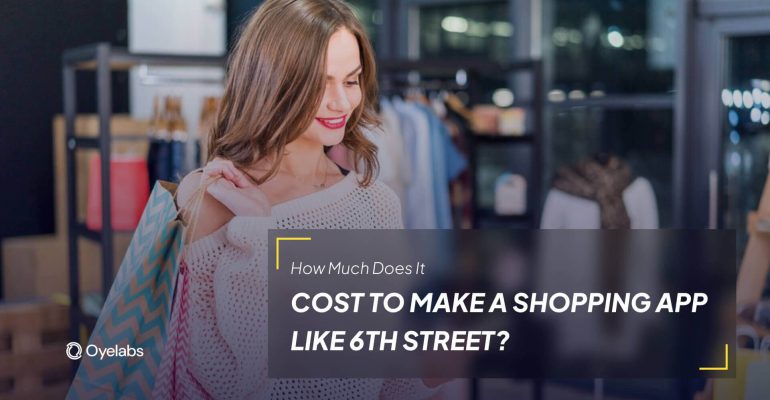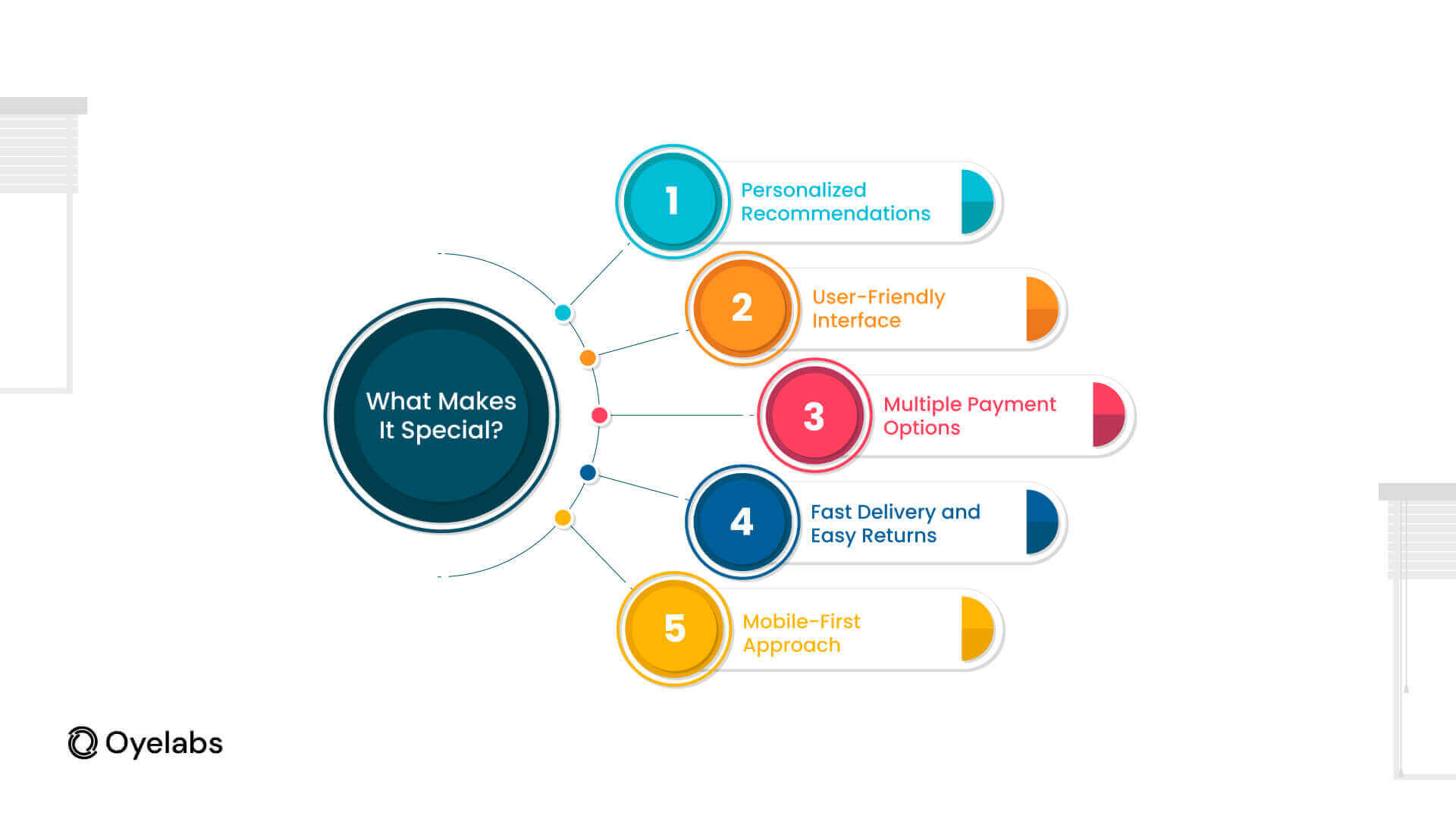How Much Does It Cost to Develop an App Like 6th Street

How Much Does It Cost to Develop an App Like 6th Street
Last Updated on October 25, 2024
The eCommerce industry has been booming in recent years, and businesses are increasingly shifting towards mobile platforms to cater to the growing number of online shoppers. If you’re considering creating a shopping app similar to 6th Street, you’re likely wondering about the costs involved. Building an eCommerce app is a significant investment, and understanding where your money will go is critical to making informed decisions.
In this blog, we’ll break down the factors that influence the cost of building a shopping app like 6th Street, provide an estimated range of expenses, and explore key features contributing to a high-quality user experience. Whether you’re an entrepreneur looking to launch a new venture or a retailer expanding your digital presence, this guide will help you navigate the financial aspects of app development.
Understanding 6th Street: What Makes It Special?

Before we dive into the costs, let’s take a moment to understand what makes 6th Street stand out. 6th Street is an online fashion and lifestyle shopping platform offering a wide variety of clothing, shoes, accessories, and more from top brands. It provides a seamless shopping experience across its website and mobile app, with features such as:
- Personalized Recommendations: Tailored suggestions based on user behavior and preferences.
- User-Friendly Interface: Clean design and easy navigation that enhance the customer experience. However, to enhance overall customer satisfaction, you must know about the pain points of e-commerce customers.
- Multiple Payment Options: Including credit cards, cash on delivery, and digital wallets.
- Fast Delivery and Easy Returns: Efficient logistics for a hassle-free shopping experience.
- Mobile-First Approach: A well-optimized app with a responsive, mobile-first design.
Creating an app with similar functionality requires careful planning, attention to detail, and significant investment. Let’s break down the costs involved.
Key Factors Influencing the Cost of a Shopping App

Several factors will determine how much you’ll need to spend on developing a shopping app like 6th Street. Here’s a breakdown of the main components:
App Complexity and Features
The complexity of your app and the number of features you include will have the biggest impact on your overall costs. An app like 6th Street would fall into the medium-to-high complexity category due to the variety of features required to provide a seamless shopping experience. Some of the key features include:
- User Authentication and Profiles: Allowing customers to sign up, log in, and manage their accounts.
- Product Catalog and Search Functionality: Displaying a wide range of products with filters and search options.
- Payment Gateway Integration: Supporting multiple payment methods such as credit cards, PayPal, digital wallets, and cash on delivery. A platform like PayPal attached to your app streamlines your payment gateways.
- Shopping Cart and Checkout Process: Enabling users to add products to their cart, review items, and complete the checkout.
- Push Notifications: Keeping users informed about promotions, discounts, and order updates.
- Order Tracking: Allowing customers to track their orders in real-time.
- Customer Support: Offering live chat, email, or phone support within the app.
The more features you add, the higher the development cost. Basic apps with fewer features may cost less, but to compete in the market, you’ll need to include essential eCommerce features that will drive engagement and conversion.
Platform: iOS, Android, or Both
You’ll also need to decide whether you want to build your app for iOS, Android, or both platforms. A native app (one developed specifically for either iOS or Android) will offer the best performance and user experience, but it can be more expensive because you’ll need to develop two separate versions.
Alternatively, you could develop a cross-platform app that works on both operating systems, which can save time and money. However, cross-platform apps may not perform as well as native apps and can have limitations in terms of design and functionality.
Design and User Experience
The design of your app plays a crucial role in attracting and retaining users. A shopping app like 6th Street needs a clean, intuitive design that makes it easy for users to browse products, navigate through categories, and complete purchases with minimal friction.
You’ll need to invest in the following design elements:
- UI/UX Design: Creating an intuitive user interface and ensuring a smooth user experience.
- Branding and Visuals: Developing a unique look that aligns with your brand identity.
- Responsive Design: Ensuring the app looks and works well on different devices and screen sizes.
A custom design with animations, transitions, and other interactive elements can increase costs, but it’s essential for creating a memorable and user-friendly experience.
Backend Development
The backend powers your app, handling tasks such as user authentication, managing product databases, processing payments, and sending notifications. Building a robust backend infrastructure requires skilled developers, especially for a complex eCommerce app like eBay or 6th Street. Key components of backend development include:
- Database Management: Organizing and storing product data, user information, and order details.
- Server Management: Ensuring the app can handle high traffic and large numbers of users without crashing.
- API Integration: Connecting your app to third-party services such as payment gateways, shipping providers, and customer support tools.
A well-built backend ensures your app runs smoothly and can scale as your user base grows, but it also adds to the overall cost of development.
Third-Party Services and Integrations
To provide a full suite of features, you’ll need to integrate several third-party services into your app. Some of the common integrations include:
- Payment Gateways (e.g., Stripe, PayPal): These providers charge a fee per transaction, but integrating them into your app will involve additional development costs.
- Shipping and Delivery APIs: These are used to track orders and provide shipping options.
- Analytics Tools: To monitor user behavior and app performance (e.g., Google Analytics, Firebase).
- CRM Systems: For managing customer relationships and marketing automation.
- Push Notification Services: To send personalized messages and offers to users (e.g., OneSignal, Firebase).
The cost of these integrations varies depending on the services you choose and the complexity of the integration.
App Maintenance and Updates
Your app will require ongoing maintenance and updates after it’s launched. This includes:
- Bug Fixes: Addressing any issues that arise as users interact with the app.
- Feature Updates: Adding new features and improving existing ones based on user feedback.
- Security Updates: Ensuring your app remains secure and protected against vulnerabilities.
The cost of maintenance typically ranges from 15% to 20% of the initial development cost per year. Neglecting maintenance can lead to performance issues, security risks, and a poor user experience.
Marketing and Promotion
Once your app is ready, you’ll need to invest in marketing to attract users and drive downloads. Common marketing channels for shopping apps include:
- App Store Optimization (ASO): Improving your app’s visibility in the Apple App Store and Google Play Store.
- Paid Advertising: Running ads on platforms like Google, Facebook, and Instagram to promote your app.
- Influencer Marketing: Partnering with influencers to reach your target audience.
- Email Marketing: Sending personalized promotions and offers to your user base.
Marketing costs can vary widely depending on your strategy and budget, but they are essential to ensuring your app’s success.
Estimated Expenses for Developing a Shopping App Like 6th Street
Now that we’ve covered the key factors, let’s look at some ballpark estimates for developing a shopping app like 6th Street. Keep in mind that these numbers can vary based on your location, the developers you hire, and the complexity of your app.
Cost Breakdown
App Development Costs
- Basic Version: $30,000 to $50,000
- Medium Complexity (like 6th Street): $60,000 to $150,000
- High Complexity (with advanced features): $200,000 and up
Design Costs
- Basic Design: $5,000 to $10,000
- Custom UI/UX Design: $15,000 to $30,000
- Backend Development
Backend Development
- Basic Backend: $10,000 to $20,000
- Advanced Backend with Multiple Integrations: $30,000 to $70,000
Third-Party Integrations
- Payment Gateways, Shipping, CRM, etc.: $5,000 to $15,000
App Maintenance
- Annual Maintenance (15%-20% of development cost): $10,000 to $30,000 per year
Marketing and Promotion
- Initial Marketing Campaigns: $10,000 to $50,000
- Ongoing Marketing: Varies based on strategy and budget
= Total Estimated Cost: $60,000 to $250,000+
Also Read: Estimating Costs for Developing an App Like Trikart
Develop your app like 6th Street with Oyelabs
Develop your app like 6th Street with Oyelabs, a leading eCommerce app development company. Our expert team will help you create a feature-rich, user-friendly shopping app that delivers a seamless experience for your customers. From custom UI/UX design to secure payment integrations and advanced order tracking, we handle every aspect of the development process. With Oyelabs, you’ll get a scalable, high-performance app tailored to your brand’s unique needs, ensuring success in the competitive online retail market. Let’s transform your eCommerce vision into a reality—partner with Oyelabs today!
Conclusion
Building a shopping app like 6th Street is a substantial investment, but with the right planning and development team, it can be a highly rewarding endeavor. By understanding the factors that influence costs—such as app complexity, design, backend development, and third-party integrations—you’ll be better equipped to allocate your budget and create an app that delivers a seamless shopping experience to your users. If you’re looking for eCommerce solutions, connect with Oyelabs today!
Also Read: Cost to Develop a Mobile App Like Best Buy




